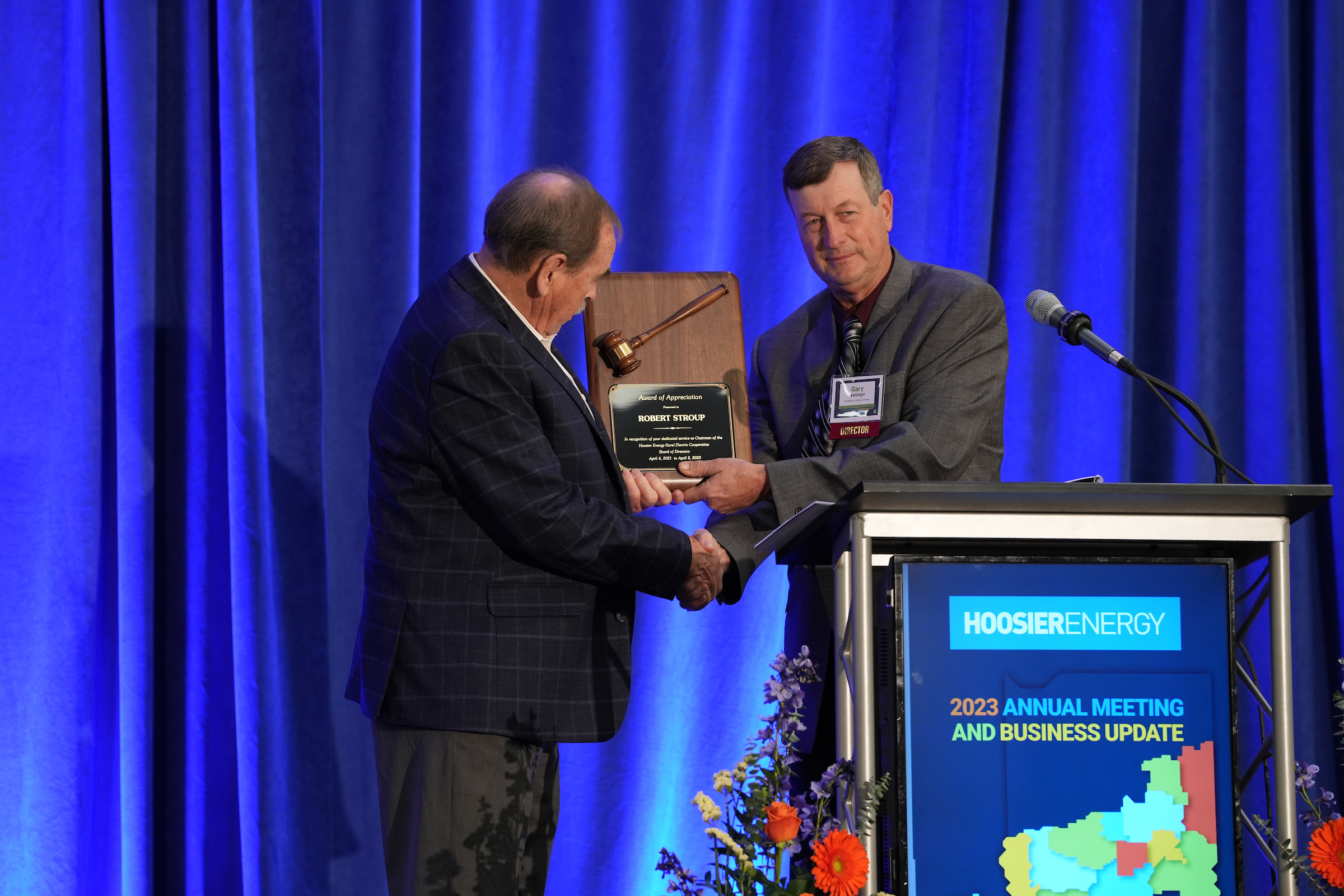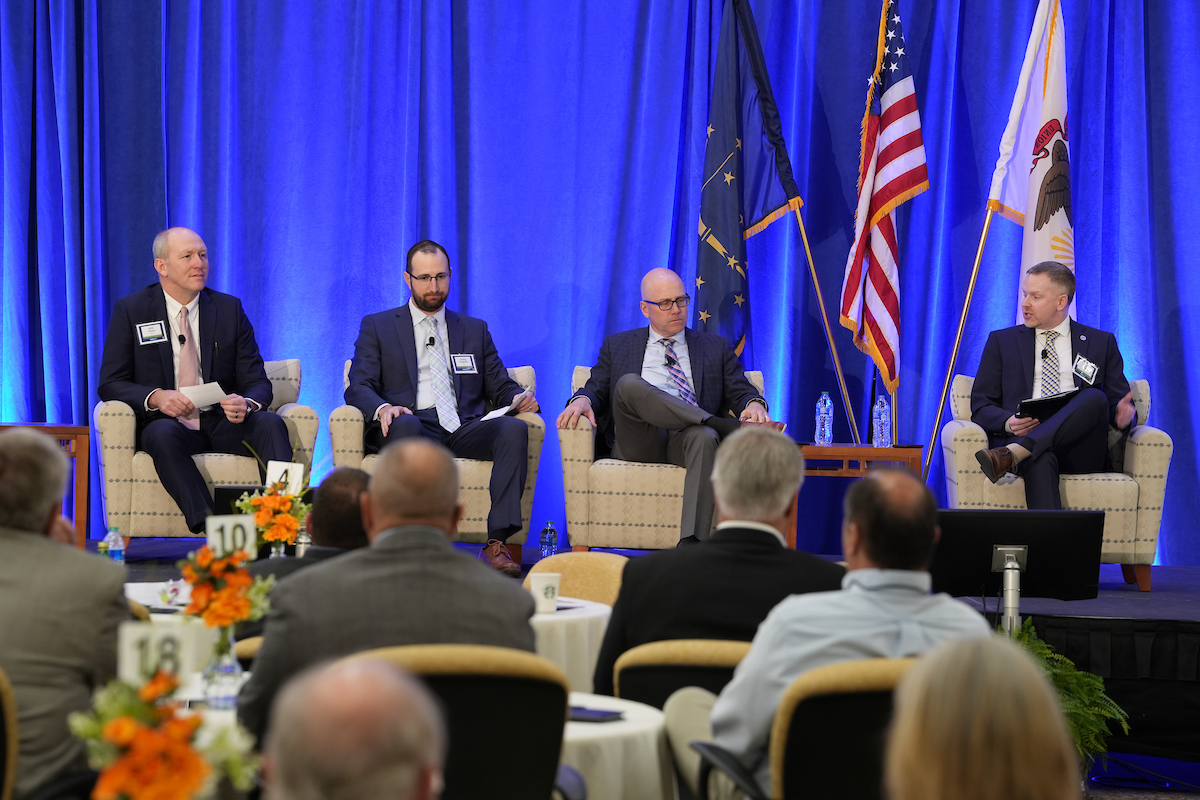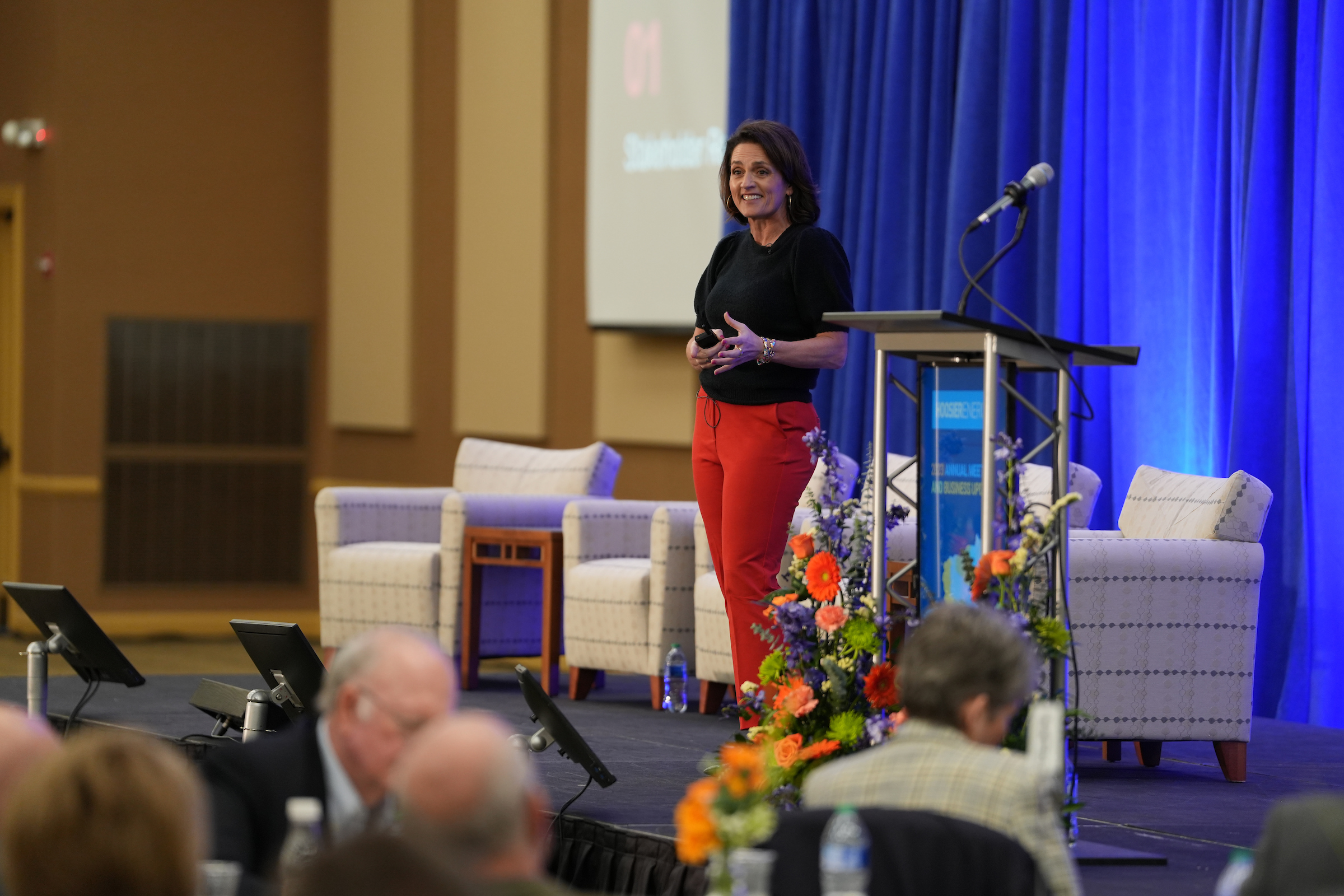Complex issues. Cooperative solutions.
The theme for Hoosier Energy’s 2023 Annual Meeting at French Lick Resort on April 5 produced a smorgasbord of tasty morsels for attendees to consider.
The appetizer was the usual business of acknowledging those who have served on the Board of Directors for the past year and confirming the appointment of those who will serve on the board for the next year. As an added treat, outgoing Chairman Bob Stroup of RushShelby Energy was recognized with a plaque featuring his now-retired gavel. Stroup celebrated 30 years as a Hoosier director this year.

Gary Waninger, right, presents a plaque to outgoing Hoosier Energy Board of Directors Chairman Bob Stroup.
New officers elected were Chairman Gary Waninger of Southern Indiana Power, Vice Chairman David Smith of Southeastern Indiana REMC, Secretary Jodie Creek of Whitewater Valley REMC and Treasurer John Edwards of Daviess-Martin County REMC.
The first dish served was courtesy of Tom Halverson, President and CEO of CoBank, who stated that as a graduate of Wabash College and one-time resident of Crawfordsville, he considers himself an honorary Hoosier. Halverson spoke on Demography and Destiny: Population Trends in Rural America. It was a presentation that included, in his own words, “nerdy but necessary graphs and data.”
Those graphs and data included global population trends, U.S. population trends and rural population trends, the latter of which clearly influenced by the COVID-19 pandemic.
“Is this change we’re seeing and experiencing, is it a permanent structural trend, and if it is, how can we ensure that rural America is the beneficiary?” Halverson asked early in his presentation.
The answer ultimately came a little later with the introduction of what he called “success factors.”
The six identified were: Broadband (robust connectivity essential), Healthcare and Education (quality products on both fronts a must), Housing (urbanites and suburbanites won’t move to subpar accommodations), Immigration (diversity key to growth) and Government (demonstrated ability to deliver value through government services).
He concluded, prior to a question-and-answer session with Hoosier Energy President and CEO Donna Walker, with a challenge.
“We believe urban migration is indeed structural, not cyclical, and will continue for the long-term because remote work is not going to disappear,” Halverson said. “A percentage of people who needed to live in urban areas will choose to live in rural areas instead. This won’t be distributed evenly across rural America, but there is an opportunity for population growth if (rural areas) want it with the success factors. Without them, (some areas) won’t see a benefit from this trend.”
Following a break, a panel of Hoosier Energy executive staff provided some lighter fare by discussing how Hoosier Energy approaches complexity to develop cooperative solutions.
Questions included:
- How do we ensure reliability and still maintain affordability while meeting sustainability requirements?
- How do we navigate this new era and balance priorities from a financial perspective?
- What are the most significant variables currently impacting the Hoosier Energy workforce?
- How are we approaching and implementing new strategies for member engagement?
- Looking towards the future, what are some of the key areas on the horizon for Hoosier Energy?
While everyone in attendance chewed on those answers, a physical lunch was served and followed by an annual tradition of awarding a door prize. Brian Koetter of Harrison REMC was the winner, taking home an electric weed eater and lawnmower.
Next out of the frying pan and into the fire was a panel discussion on Competing Policy Interest: Importance of Sustained Advocacy. The group featured NRECA VP of Legislative Affairs Hill Thomas, Indiana Electric Cooperatives CEO John Cassady and Association of Illinois Electric Cooperatives President and CEO Craig Sondgeroth with moderator Matt Randall, Manager of Public Policy and Community Relations for Hoosier Energy.

Panelists, from left, Hill Thomas, Craig Sondgeroth and John Cassady join moderator Matt Randall on stage at the Hoosier Energy Annual Meeting.
Cassady noted that there have been over 1,200 bills introduced so far this year in Indiana, while Illinois has seen over 6,500 bills introduced according to Sondgeroth.
Meanwhile, in Washington, D.C., Thomas sees himself in the heart of the action. With Congress running on two-year cycles, he said 90% of the work gets done in the first year and 90% of the 90% gets done in the first half of the first year. The things at the top of the potential list are modernizing the federal permit process and addressing supply chain issues. Also, the Farm Bill expires in September, which is something that is addressed and usually renewed every five years.
The second part of the discussion centered around political dysfunction. Indiana has a super majority of Republicans, Illinois has a super majority of Democrats and D.C. is a split decision with Republicans controlling the House and Democrats the Senate and White House.
The panel wrapped up by taking on the subject of how to take advantage as a cooperative to stay at the table in legislative discussions.
“When you walk in the room as an electric cooperative, you come with trust and credibility,” Sondgeroth emphasized. “Our history helps.”
Cassady added: “We can’t pass up the opportunity to start with the basics of all the virtues of being a cooperative and what that means and how that’s different. Never shy away from repetition.”
For Thomas, it’s when not if.
“The vote is going to happen, the decision is going to get made, the bill is going to get written whether you’re there or not,” he said. “To be there early, to have a long-term strategy to educate and build relationships helps your cause.”
The final course of the day was both cause and effect, as Molly McPherson of Indestructible PR explained in her session on Communicating Complexity & Cooperation in a Rapidly Changing Energy Environment.

Molly McPherson of Indestructible PR speaks at the Hoosier Energy Annual Meeting on April 5, 2023, in French Lick.
Consulting with many utilities, McPherson has seen the complex issues weaponized.
“They take something, twist it and 80% is true, 20% is intentional misinformation, then put it out there,” she said. “Then the board and the manager have to deal with misinformation, so they’re weaponizing complexity. Now the press is involved, board elections are coming up.”
But McPherson emphasized that such an approach is trying to bait both the cooperative and its members away from the truth.
“If you run a cooperative with a value system, like the seven cooperative principles, if it’s led by someone who believes in transparency and good business practices and establishes trust, they cannot bring you down,” she said. “Don’t be afraid to tell the truth. Rip off the band-aid, tell (members) what’s happening in clear, concise messaging. People will sometimes hire me to try and work around something, but no, the path is through it.”
As an example, McPherson played a video on energy conservation from the 1970s with the tagline, “Dial It Down.”
Beyond simplifying the message, she also encouraged cooperatives to look inside.
Among the many stakeholders involved in a utility, McPherson said the most overlooked is the staff.
“It’s like in a horror film when they say, ‘The murderer is in the building,’” she said. “I say that all the time. It’s the staff. It’s the lack of culture.”
If a level of trust is established internally, then it will extend externally.
“The most important thing about communicating complexity in this industry is this idea of trust,” McPherson said. “Every single plan, external and internal and media crisis communications, all come down to trust. If stakeholders trust you, you likely will not have issues.”
And whatever complex issues you might have will always have a cooperative solution.